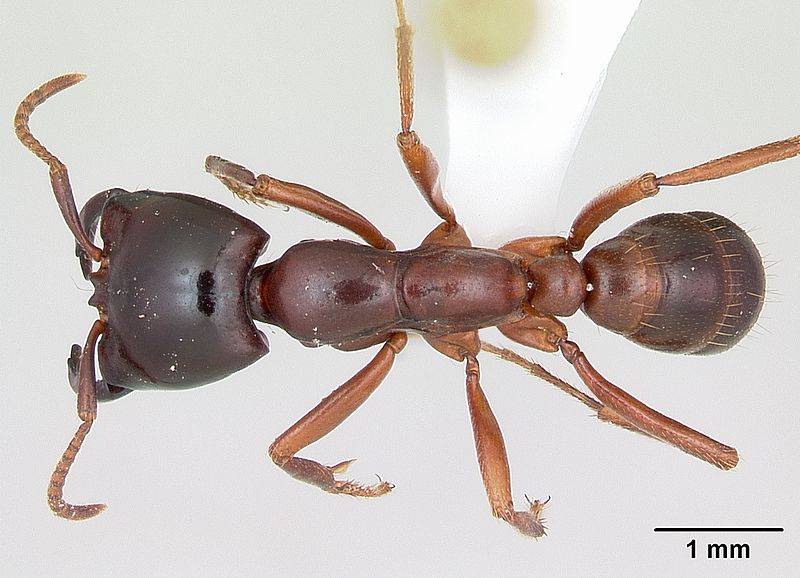I guess you could say that I have been programmed to notice giant creepy crawly things. Starting when my son brought home a book about “Real Life Monsters”, my family has not been able to stop talking about one of the book’s featured monsters, the Goliath Bird Eater spider. While the book’s other stars, the giant squids and great white sharks, were pronounced by my son to be “cool”, a spider that is the size of a dinner plate and eats birds, is the thing of nightmares. Both my kids will fearfully bring up these giant arachnids anytime a hairy spider is spotted. [Note: Goliath Bird Eaters live in South America, not Wisconsin].

Given the number of family discussions I have had about gigantic arachnids, it was only natural that a headline about a hummingbird-sized ant that once roamed Wyoming caught my attention (1). Although there are living species of giant ants, the Wyoming ant is the first fossil from the extinct ant family Formiciinae to be found in the Western Hemisphere. The ant lived in the early Eocene (~49.5 Million years ago). And, unlike the cool climate insect taxa previously known to be shared between North America and Europe, this new ant, Titanomyrma lubei, was a thermophilic insect.
So why did a thermophilic insect end up in this Eocene Arctic region, which would have had mostly cool temperatures? To answer this, Dr. Archibald and his colleagues used a combination of palaeoclimatic analysis, location of other ant fossils, proportion of dicot leaf morphotypes, leaf area analysis as a prediction of annual precipitation, and population occurrence data for modern large ants. They found that all other occurrences of the Formiciinae family were associated with areas that had had an estimated mean annual temperature of at least 20°C; temperatures that are consistent with the ranges of modern large ant species.
The T. lubei sample is not the only fossil that has seemed out of its comfort zone in the Eocene Arctic. Other fossil findings, including tropical plankton and pollen from tropical palms, have also suggested a warmer history. Could it be that the Eocene Arctic was not always cool?
That is what Dr. Archibald and his colleagues think. They propose that a series of Eocene hyperthermals, brief periods of higher temperatures, allowed thermophilic creatures such as T. lubei to migrate across the intercontinental land bridges that existed at that time. Climate scientists seem to concur. They have suggested that there were several of these “brief” hot spells around 50 million years ago, including one that lasted around 170,000 years (that is brief on the geological scale at least; 2).
So the presence of a giant, fossilized, warm-loving ant in an Arctic Eocene region adds to the body of evidence that points to the occurrence of Eocene hyperthermals. Before now, the tantalizing discovery of a fossilized ant wing in Tennessee had hinted at the presence of giant ants in North America, but it took the discovery of this complete fossilized specimen from Wyoming to solidify their existence during the Arctic Eocene.

Finally, in case you were curious, the 5.1cm long hummingbird-sized fossil found in Wyoming is not the largest ant fossil ever found; one found in Germany was ~1mm longer.
And the largest living ant? That honor goes to the Queen African Driver ant. How big are they? Well let’s just say that if these ants came marching two by two you might just want a Goliath Bird Eater or two around.
References
 Archibald SB, Johnson KR, Mathewes RW, & Greenwood DR (2011). Intercontinental dispersal of giant thermophilic ants across the Arctic during early Eocene hyperthermals. Proceedings. Biological sciences / The Royal Society PMID: 21543354
Archibald SB, Johnson KR, Mathewes RW, & Greenwood DR (2011). Intercontinental dispersal of giant thermophilic ants across the Arctic during early Eocene hyperthermals. Proceedings. Biological sciences / The Royal Society PMID: 21543354 - Milius, S. (2011) Giant ants once roamed Wyoming. Science News, 179, 9. (accessed online June 14, 2011)

Sorry, but as soon as I read “Giant Ants” I flashed on “THEM!”
One of the best 1950s monster flicks …
I can understand that reaction. The minute I saw giant ants I thought Giant spiders (also good monster movie material).